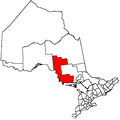|
Algoma District
Algoma District is a district and census division in Northeastern Ontario in the Canadian province of Ontario. The name was created by an American ethnologist, Henry Rowe Schoolcraft (1793–1864), who was appointed Indian agent to the Ojibwe in Sault Ste. Marie region in 1822. "Al" is derived from Algonquin, while "goma" is a variant of gomee, meaning lake or water.[3] Algoma District has shoreline along Lake Superior and Lake Huron. It has an international border crossing to the American state of Michigan, at Sault Ste. Marie. Historically, it was known for its lumber and mining industries. The rugged scenery of the region has inspired works by Canadian artists, particularly the Group of Seven. They rented a boxcar from the Algoma Central Railway to travel on excursions through this region. HistorySurviving prehistoric remains in Algoma District are concentrated around waterways. These remains date as far back as the Archaic period. There are also sites from the later Woodland period, with evidence of extensive Late Woodland habitation. Ceramics at Late Woodland sites show predominantly southeastern links, having originated from the Huron–Petun complex (broadly Ontario Iroquoian) as well as from modern-day Michigan.[4]: 28 French explorers arrived in the area by the mid-17th century. As the French penetrated into North America, they established lines of forts and trading posts, often at river mouths to control trade, especially the lucrative fur trade. In Algoma, they established Fort Michipicoten, located at the mouth of the Michipicoten River where it empties into Lake Superior. The Michipicoten was one of the geographic features depicted by Samuel de Champlain on a 1632 map.[5]: 17 This helped the French bridge the distance to Fort Kaministiquia at the head of Lake Superior, and protected the route up the Michipicoten to James Bay, providing a significant crossroads of water routes. Administrative historyAlgoma was created by proclamation in 1858[6] as a provisional judicial district of the Province of Canada comprising territory north of the French River as far west as Pigeon River, including all Canadian islands in Lakes Huron and Superior. The authorizing act of the Legislative Assembly of the Province of Canada was An Act to provide for the Administration of Justice in the unorganized Tracts of Country within the limits of this Province (known by its short title as The Temporary Judicial Districts Act, 1857). The district seat is Sault Ste Marie, Ontario. However, it is noted that Thessalon is where the Algoma District Services Administration Board is located. As the population grew and the northern and northwestern boundaries of Ontario were determined by the Judicial Committee of the Privy Council, Algoma shrank. Other districts were created from it by the provincial government of Ontario:
GeographyRivers Algoma District is crossed by a number of rivers, which historically were used as transportation and trade corridors. The Hudson's Bay Company chose key riverside or river mouth locations for a number of its trading posts in the district. One example was Fort Michipicoten, located at the Michipicoten River's mouth. The rivers flow in a number of directions, some crossing through other districts to ultimately empty into faraway water bodies such as James Bay. Others drain into the Great Lakes Basin via Lake Huron or Lake Superior. Major rivers in Algoma District include:
ForestsIn the Algoma section, the characteristic forest mixture consists of yellow birch, white spruce, balsam fir, sugar maple, hop-hornbeam, and eastern white cedar. Eastern white pine and occasional red pine (Pinus resinosa) dominate on the upper, steep south-facing slopes; white spruce, eastern white cedar, and balsam fir occupy the middle and lower slopes. A white spruce–balsam fir association, which usually includes white birch and black spruce, is prominent on the river terraces and adjoining flats in the northern part of the Section (Rowe 1972).[7] SubdivisionsCommunities within these subdivisions are added in parentheses. Cities
Towns
Townships
Village
Reserves
Unorganized areas
DemographicsAs a census division in the 2021 Census of Population conducted by Statistics Canada, the Algoma District had a population of 113,777 living in 51,709 of its 59,854 total private dwellings, a change of −0.3% from its 2016 population of 114,094. With a land area of 48,281.36 km2 (18,641.54 sq mi), it had a population density of 2.4/km2 (6.1/sq mi) in 2021.[8] Canada census – Algoma community profile
HighwaysKing's HighwaysSecondary highwaysTertiary highways
Protected areas
Attractions
See alsoReferences
Further reading
External linksWikimedia Commons has media related to Algoma District, Ontario. |
|||||||||||||||||||||||||||||||||||||||||||||||||||||||||||||||||||||||||||||||||||||||||||||||||||||||||||||||||||||||||||||||||||||||||||||||||||||||||||||||||||||||||||||||||||||






